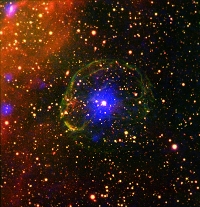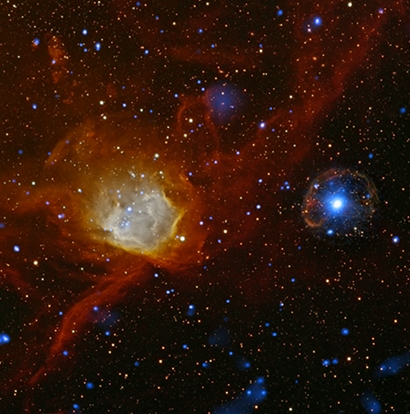Strangely slow pulsar discovered nestled in young supernova remnant
20 December 2011
Astronomers have discovered a very slowly rotating X-ray pulsar still embedded in the remnant of the supernova that created it. This unusual object was detected on the outskirts of the Small Magellanic Cloud, a satellite galaxy of the Milky Way, using data from a number of telescopes, including ESA's XMM-Newton. A puzzling mismatch between the fairly young age of the supernova remnant and the slow rotation of the pulsar, which would normally indicate a much older object, raises interesting questions about the origin and evolution of pulsars.
 |
|
The X-ray pulsar SXP 1062 embedded in the remnant of the supernova that created it. |
The spectacular supernova explosion that marks the end of a massive star's life also has an intriguing aftermath. On the one hand, the explosion sweeps up the surrounding interstellar material creating a supernova remnant that is often characterised by a distinctive bubble-like shape, on the other hand, the explosion also leaves behind a compact object – a neutron star or a black hole. Since supernova remnants shine only for a few tens of thousands of years before dispersing into the interstellar medium, not many compact objects have been detected while still enclosed in their expanding shell.
An international team of astronomers has now discovered one of these rarely observed pairs, consisting of a strongly magnetised, rotating neutron star – a pulsar – surrounded by the remains of the explosion that generated it.
The newly found pulsar, named SXP 1062, is located at the outskirts of the Small Magellanic Cloud (SMC), one of the satellite galaxies of the Milky Way. SXP 1062 is an X-ray pulsar, part of a binary system in which the compact object is accreting mass from a companion star, resulting in the emission of copious amounts of X-rays. The astronomers first detected the pulsar's X-ray emission using data from ESA's XMM-Newton as well as NASA's Chandra space-based observatories. A later study of optical images of the source and its surroundings revealed the bubble-shaped signature of the supernova remnant around the binary system.
"The most interesting aspect of this pulsar is possibly its extremely long period – 1062 seconds – which makes it one of the slowest pulsars on record," comments Lidia Oskinova from the Institute for Physics and Astronomy in Potsdam, Germany, coordinator of the team that analysed the X-ray data. Pulsars rotate quite rapidly in their early stages, with periods of only a fraction of a second, and then slow down gradually with age. "Slowly spinning pulsars are particularly difficult to detect. Only a few with periods longer than a thousand seconds have been observed to date," she adds.
To further investigate the binary system hosting this unusually slow pulsar, the team looked at the source at optical wavelengths, conducting follow-up observations with the European Southern Observatory's Very Large Telescope (VLT) and inspecting archival and newly acquired images from the Cerro Tololo Inter-American Observatory (CTIO).
"The VLT spectra confirm that the pulsar is accreting mass from a massive, hot, blue 'Be' star. The two bodies form a Be/X-ray binary, a class of X-ray binary that's very common in the SMC," explains Vincent Hénault-Brunet, PhD student at the Institute of Astronomy, University of Edinburgh, UK. Hénault-Brunet is the first author of a paper in which these results are reported. It will appear as a letter in the January 2012 issue of the Monthly Notices of the Royal Astronomical Society.
The result relies on the combined power of a number of complementary observatories. "XMM-Newton's large effective area was instrumental in achieving high-sensitivity observations of the pulsar and the supernova remnant around it over a broad range of X-ray wavelengths," says Norbert Schartel, ESA's XMM-Newton Project Scientist. These data were combined with Chandra's, which probe the source at a higher angular resolution, albeit with lower sensitivity, to arrive at a comprehensive picture of the pulsar's X-ray emission.
The optical images, on the other hand, revealed the bubble-shaped nebula that harbours the binary system. This nebula appears to be the remnant of the supernova from which the pulsar itself originated. "Not many pulsars have been observed within their supernova remnant, and this is the first clear example of such a pair in the SMC," comments Hénault-Brunet.
Opportunities like this enable astronomers to study the complex relationship between the expanding remains of stellar explosions and the compact objects they leave behind. The case of SXP 1062 is particularly puzzling because of an apparent mismatch between the ages of the supernova remnant and that of the pulsar.
"Extremely slow rotation in pulsars normally points to old objects – something that doesn't quite agree in this case with the fairly young age of the supernova remnant, which ranges between 20,000 and 40,000 years," notes Oskinova.
The reason for the slow rotation of this pulsar remains a mystery: if it was born with a normal spin rate, how could it slow down to this extent in such a short time? Alternatively, was the pulsar born with a much slower rotation period than typically expected? Since the pulsar is located in the Wing of the SMC, an interesting peripheral region of this galaxy that is characterised by low density of stars, gas and dust, as well as by low metallicity, the environment may have played a role by affecting the properties of the pulsar's progenitor star before its demise in a supernova explosion.
The rich data set that this team of astronomers have gathered may yet contain an explanation for this peculiar case. "Our plan is to fully mine the X-ray data to study the system's variability in greater detail, and further study the optical spectra to investigate the properties of the companion star," says Oskinova. "We can't wait to see what the data tell us."
Notes for editors
The findings presented here report the discovery of a Be/X-ray binary system consisting of a pulsar, SXP 1062, and a companion 'Be' star, 2dFS 3831, located in the Wing of the Small Magellanic Cloud (SMC).
The study is based on complementary data from ESA's XMM-Newton and NASA's Chandra X-ray observatories. XMM-Newton's large effective area was key to high-sensitivity observations of the pulsar and supernova remnant over a broad range of X-ray wavelengths, while the Chandra data provide higher angular resolution, albeit at a lower sensitivity.
The Fibre Large Array Multi Element Spectrograph (FLAMES) on ESO's Very Large Telescope was used for follow-up optical spectroscopy. Archival images from the Magellanic Cloud Emission-Line Survey (MCELS) conducted at NOAO's Cerro Tololo Inter-American Observatory, as well as newly acquired images, were also used to study this portion of the sky in a number of emission lines: the H-alpha line of neutral hydrogen and two forbidden lines of oxygen [OIII] and sulphur [SII]. These lines trace emission from some of the elements produced during supernova explosions, making them excellent diagnostic tools for the study of supernova remnants.
An X-ray pulsar is one component of a binary system where the X-ray emission is produced by accretion of matter from the stellar companion onto the pulsar. Such pulsars generally have longer periods – typically between 1 and several hundred seconds – than the more common radio pulsars.
Neutron star X-ray binaries are classified into high-mass X-ray binaries (HMXB) and low-mass X-ray binaries (LMXB) depending on the mass of the companion star. HMXB are further divided into supergiant X-ray binaries (SGXB) and Be/X-ray binaries (BeXB). Be/X-ray binaries consist of a neutron star and a 'Be' companion star – a B-type star characterised by prominent hydrogen emission lines in its spectrum. Virtually all known Be/X-ray binaries harbour X-ray pulsars.
The SMC, a satellite galaxy of the Milky Way, is known to host about 50 HMXB – a surprisingly large population considering that its mass is only a few per cent of that of the Milky Way, in which about 70 HMXB are known to exist to date. All but one of the HMXB detected in the SMC are BeXB.
Contacts
Vincent Hénault-Brunet
Institute for Astronomy, University of Edinburgh
Edinburgh, UK
Email: vhb roe.ac.uk
roe.ac.uk
Phone: +44-131-668-8236
Lidia Oskinova
Institute for Physics and Astronomy, University of Potsdam
Potsdam, Germany
Email: lida astro.physik.uni-potsdam.de
astro.physik.uni-potsdam.de
Phone: +49-331-977-5910
Norbert Schartel
ESA XMM-Newton Project Scientist
Directorate of Science and Robotic Exploration
European Space Agency
Email: Norbert.Schartel esa.int
esa.int
Phone: +34-91-8131-184



